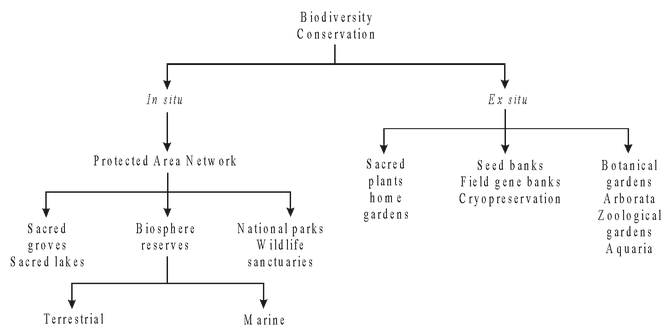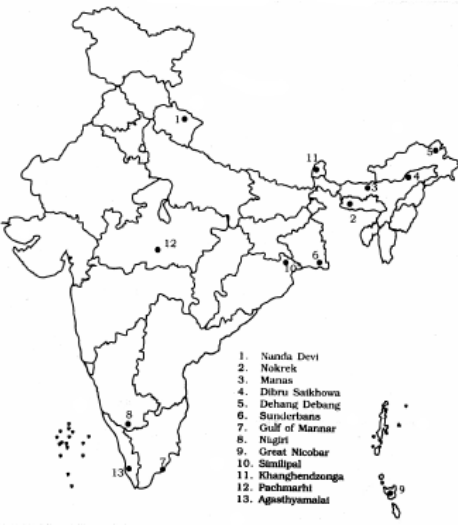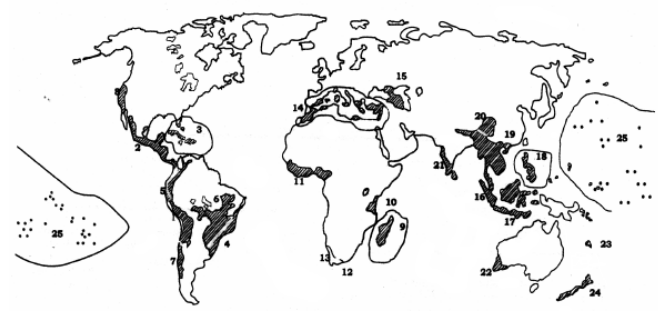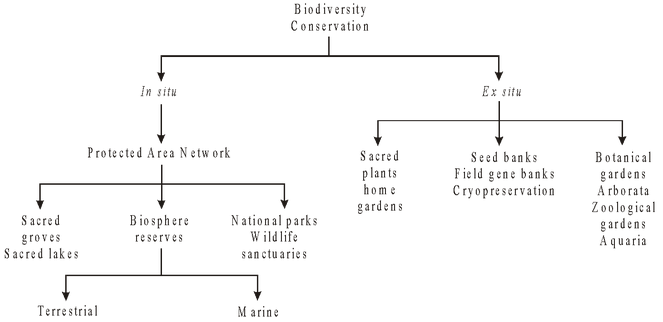IUCN Categories
Biodiversity of Class 12
About IUCN
Threatened species are those living species which have been greatly reduced in their number or whose natural habitats have been disturbed due to which these are near extinction and may become extinct causative factors continue. It is believed that at least 10 per cent of the living species are in danger.
IUCN Full form
The International Union for Conservation of Nature and Natural Resources (IUCN, Hq. at Morgis in Switzerland) is maintaining a Red Data Book which contains a record of animals which are known to be in danger. On the basis of degree of threat eight red list categories have been identified as given in Table.
Table : The IUCN red list categories on the basis of threat.
Red List Category Character
-
Extinct When there is no reasonable doubt that the last individual has died.
-
Extinct in the wild When extensive surveys, in known and/or expected habitats, have not recorded an individual.
-
Critically Endangered When it is facing an extremely high risk of extinction in the wild in the near future.
-
>Endangered When it is not Critically Endangered, however is facing a very high risk of disappearance in the wild in the immediate future.
-
Vulnerable When it is not Critically Endangered or Endangered, but is facing a high risk of disappearance in the wild in the medium-term future.
-
Lower Risk When it has been evaluated and does not satisfy the criteria for Critically Endangered, Endangered or Vulnerable.
-
Data Deficient When there is not sufficient information to make a direct, or indirect, assessment of its risk of extinction.
-
Not Evaluated When it has not yet been assessed against any of the above criteria.
Following three categories have been discussed and are defined here for the purposes of conservation :
Endangered (E) species. These are those species (or taxa) whose number have been reduced to a critical level, or whose natural habitats have been adversely affected. So these are near extinction and may become extinct if these causal factors continue operating. In India, the wildlife (Protection) Act, 1972 provides four schedules categorising the fauna of India based on their conservation status. It is considered that about 81 species of mammals, 38 species of birds and 18 species of amphibians and reptiles are endangered in India.
Some examples of endangered species in India are :
-
Critically endangered Plant. Berberis nilghiri Animal. Sus salvaninus (Pigmy hog)
-
Endangered Plant : Bentinckia nicobarica Animal : Ailurus fulgens (Red panda)
Vulnerable (V) species.
These are those species (or taxa) whose populations are still abundant but their home range has been adversely affected, so these may become endangered if these factors continued.
Some of the common vulnerable animal species of India are :
- Golden Langur – Presbytis geeri
- Leopard cat – Felis bengalensis
- Black buck – Antilope cervicapra common vulnerable species is Cupressus cashmeriana.
Rare (R) Species.
These are those threatened species which are very less in number and are usually confined in a specific area; or very thinly distributed over wide geographical area. Though these are not endangered presently but may become endangered due to their less number.
Some rare Indian animal species are :
- Snow loris – Nycticebus coucang
- Indian desert cat – Felis sylvestris
- Wild yak – Bos mutus
- Malkhor – Capra falconeri
- Gharial – Gavialis gangeticus

Fig. : The percentage of threatened angiosperms, amphibians, reptiles, birds and mammals categorised as Critically Endangered, Endangered, Vulnerable and at Lower Risk
We know that ecosystems are undergoing change due to pollution, invasive species, over exploitation by humans, and climate change. Most people are beginning to recognise that diversity at all levels – gene pool, species and biotic community is important and needs to be conserved. There is also an ethical imperative of stewardship, i.e., we have a moral duty to look after our planet and pass it on in a good health to our future generations. We should not deprive the future generations from the economic and aesthetic benefits that they can derive from biodiversity. The decisions we make now, as individuals and as a society, will determine the diversity of genes, species and ecosystems that remain in future. We may appreciate the fact that the most effective and efficient mechanism for conserving biodiversity is to prevent further destruction or degradation of habitats by us. We require more knowledge to conserve biodiversity in reduced space and under increased pressure of human activities. There are two basic strategies of biodiversity conservation, in situ (on site) and ex situ (off site).
IN SITU CONSERVATION STRATEGIES
The in situ strategies emphasise protection of total ecosystems. The in situ approach includes protection of a group of typical ecosystems through a network of protected areas.
PROTECTED AREAS
These are areas of land and/or sea, especially dedicated to the protection and maintenance of biological diversity, and of natural and associated cultural resources. These are managed through legal or other effective means. Examples of protected areas are National Parks, and Wildlife Sanctuaries. The earliest national parks, the Yellowstone in USA and the Royal near Sydney, Australia, were chosen because of their scenic beauty and recreational values. Many similar areas throughout the world now protect rare species or wilderness areas. World Conservation Monitoring Centre has recognised 37,000 protected areas around the world. As of September 2002, India has 581 protected areas (89 National Parks and 492 Wildlife Sanctuaries), covering 4.7 per cent of the land surface, as against 10 per cent internationally suggested norm. The Jim Corbett National Park was the first National Park established in India.
Some of the main benefits of protected areas are: maintaining viable populations of all native species and subspecies; maintaining the number and distribution of communities and habitats, and conserving the genetic diversity of all the present species; preventing human-caused introductions of alien species: and making it possible for species/habitats to shift in response to environmental changes.
BIOSPHERE RESERVES
Biosphere reserves are a special category of protected areas of land and/or coastal environments, wherein people are an integral component of the system. These are representative examples of natural biomes and contain unique biological communities. The concept of Biosphere Reserves was launched in 1975 as a part of UNESCO’s Man and Biosphere Programme, dealing with the conservation of ecosystems and the genetic resources contained therein. Till May 2002, there were 408 biosphere reserves located in 94 countries. There are 13 biosphere reserves in India. In India, Biosphere Reserves are also notified as National Parks.A Biosphere Reserve consists of core, buffer and transition zones. The natural or core zone comprises an undisturbed and legally protected ecosystem. The buffer zone surrounds the core area, and is managed to accommodate a greater variety of resource use strategies, and research and educational activities. The transition zone, the outermost part of the Biosphere Reserve, is an area of active cooperation between reserve management and the local people, where in activities like settlements, cropping, forestry and recreation and other economic uses continue in harmony with conservation goals.

Fig. : The Biosphere Reserves in India
The main functions of biosphere reserves are :
- Conservation : To ensure the conservation of landscapes, ecosystems, species and genetic resources. It also encourages traditional resource use.
- Development : To promote economic development which is culturally, socially and ecologically sustainable.
- Scientific research, monitoring and education : The aim is to provide support for research, monitoring, education and information exchange related to local, national and global issues of conservation and development.
SACRED FORESTS AND SACRED LAKES
A traditional strategy for the protection of biodiversity has been in practice in India and some other Asian countries in the form of sacred forests. These are forest patches of varying dimensions protected by tribal communities due to religious sanctity accorded to them. The sacred forests represent islands of pristine forests (most undisturbed forests without any human impact) and have been free from all disturbances; though these are frequently surrounded by highly degraded landscapes. In India, sacred forests are located in several parts, e.g., Karnataka, Maharashtra, Kerala, Meghalaya, etc., and are serving as refugia for a number of rare, endangered and endemic taxa. Similarly, several water bodies (e.g., Khecheopalri lake in Sikkim) have been declared sacred by the people, leading to protection of aquatic flora and fauna.
EX SITU CONSERVATION STRATEGIES
The ex situ conservation strategies include botanical gardens, zoos, conservation stands, gene, pollen, seed, seedling, tissue culture and DNA banks. Seed gene banks are the easiest way to store germplasm of wild and cultivated plants at low temperature in cold rooms. Preservation of genetic resources is carried out in field gene banks under normal growing conditions. In vitro conservation, especially by cryopreservation in liquid nitrogen at a temperature of –196°C, is particularly useful for conserving vegetatively propagated crops like potato. Cryopreservation is the storage of material at ultra-lowtemperature either by very rapid cooling (used for storing seeds), or by gradual cooling and simultaneous dehydration at lowtemperature (used for tissue culture). The material can be stored for a long period of time in compact, low maintenance refrigeration units.Conservation of biological diversity in botanical gardens is already in practice. There are more than 1500 botanical gardens and arboreta (botanical gardens where specific tree and shrub species are cultivated) in the world containing more than 80,000 species. Many of these now have seed banks, tissue culture facilities and other ex situ technologies. Similarly, there are more than 800 professionally managed zoos around the world with about 3,000 species of mammals, birds, reptiles and amphibians. Many of these zoos have well-developed captive breeding programmes.
The conservation of wild relatives of crop plants and the off-site conservation of crop varieties or cultures of micro-organisms provides breeders and genetic engineers with a ready source of genetic material. Plants and animals conserved in botanical gardens, arboreta, zoos and aquaria can be used to restore degraded land, reintroduce species into wild, and restock depleted populations.
Biodiversity is not uniformly distributed across the geographical regions of the earth. Certain regions of the world are mega diversity zones where a very large number of species are found. For example, India accounts for only 2.4 per cent of the land area of the world, but it contributes approximately 8 per cent species to the global diversity.
Norman Myers developed the hot spots concept in 1988 to designate priority areas for in situ conservation. The hot spots are the richest and the most threatened reservoirs of plant and animal life on earth.
The key criteria fordetermining a hot spot are: Number of endemic species, i.e., the species which are found no where else, and Degree of threat, which is measured in terms of habitat loss.
Twenty-five terrestrial hot spots for conservation of biodiversity have been identified worldwide. These hot spots together, now cover 1.4 per cent of the earth’s land area. Tropical forests appear in 15 hot spots, Mediterranean-typezones in 5, and 9 hot spots are mainly or completely made up of islands. As many as 16 hot spots are in the tropics.About 20 per cent of the human population lives in the hot-spot regions. Among the 25 hot spots of the world, two (Western Ghats and Eastern Himalayas) are found in India, and these extend into the neighbouring countries also. These areas are rich in flowering plants, also in reptiles, amphibians, swallow-tailed butterflies and some mammals; and also show a high degree of endemism.
The eastern Himalayan hot spot extends to the north-eastern India and Bhutan. The temperate forests are found at altitudes of 1780 to 3500 meters. Many deep and semi-isolated valleys found in this region are exceptionally rich in endemic plant species. Besides being an active centre of evolution and rich diversity of flowering plants, the numerous primitive angiosperm families (e.g., Magnoliaceae and Winteraceae) and primitive genera of plants, like Magnolia and Betula, are found in eastern Himalaya.
The Western Ghat region lies parallel to the western coast of Indian peninsula for almost 1600 km. in Maharashtra, Karnataka, Tamil Nadu and Kerala. The forests at low elevation (500 m above mean sea level) are mostly evergreen, while those found at 500-1500 meter height are generally semi-evergreen forests. The Agasthyamalai hills, the Silent Valley and the new Amambalam Reserve, are the two main centres of diversity.

Fig. : The terrestrial biodiversity hot spots
- Tropical Andes;
- Mesoamerica,
- Caribbean;
- Brazil’s Atlantic Forests;
- Choco/Darien/Western Ecuador;
- Brasil’s Cerrado;
- Central Chile;
- California Floristic Province;
- Madagascar,
- Eastern Arc & Coastal Forests of Tanzania/Kenya;
- West African Forests,
- Cape Floristic Province;
- Succulent Karoo;
- Mediterranean Basin;
- Caucasus;
- Sundland;
- Wallacea,
- Phillippines;
- Indo-Burma;
- Sout-Central China,
- Western Ghats/Sri Lanka;
- Southwest Australia;
- New Caledonia;
- New Zealand;
- Polynesia/Micronesia.
INTERNATIONAL EFFORTS FOR CONSERVING BIODIVERSITY
The Earth Summit held in 1992 at Rio de Janeiro resulted into .a Convention on Biodiversity, which came into force on 29 December, 1993.
The Convention on has three key objectives:
- Conservation of biological diversity.
- Sustainable use of biodiversity
- Fair and equitable sharing of benefits arising out of the utilisation of genetic resources.
The World Conservation Union and the World Wide Fund for Nature (WWF) support projects worldwide to promote conservation and appropriate development of Biosphere Reserves.
BIODIVERSITY CONSERVATION IN INDIA
Indian region has contributed significantly to the global biodiversity. India is a homeland of 167 cultivated species and 320 wild relatives of crop plants. It is the centre of diversity of animal species (zebu, mithun, chicken, water buffalo, camel); crop plants ( rice, sugarcane, banana, tea, millet); fruit plants and vegetables (mango, jackfruit, cucurbits), edible diascoreas, alocasia, colocasia; spices and condiments (cardamom, black pepper, ginger, turmeric); and bamboos and tree cotton. India also represents a secondary centre of domestication for some animals (horse, goat, sheep, cattle, yak, and donkey) and plants (tobacco, potato and maize).The biodiversity management systems for conserving biodiversity in India. The in situ conservation of biodiversity is being carried out through Biosphere Reserves, National Parks, Wildlife Sanctuaries and other protected areas by the Ministry of Environment and Forests. The joint forest management systems involve forest departments and local communities. This enables the tribal people and local communities to have access to non-wood forest products, and at the same time protect the forest resources.
The National Bureau of Plant, Animal and Fish Genetic Resources has a number of programmes to collect and conserve the germplasm of plants and animals in seed gene banks, and field gene banks for in vitro conservation. Botanical and zoological gardens have large collections of plant and animal species in different climatic regions of India.The land races and diverse food and medicinal plants are also being conserved successfully by the tribal people and women working Individually, or with various non¬governmental agencies. The women particularly have an important role in the conservation of agrobiodiversity. In India, a programme is underway to develop a system of community registers of local informal innovations related to the genetic resources, as well as natural resource management in general.

Fig. : The in situ and ex situ approaches of conserving biodiversity in India









